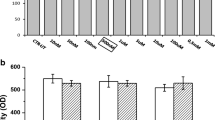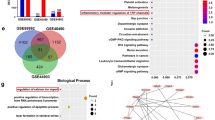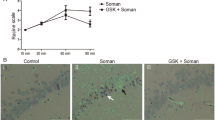Abstract
Epilepsy is a brain condition characterized by the recurrence of unprovoked seizures. Recent studies have shown that complement component 3 (C3) aggravate the neuronal injury in epilepsy. And our previous studies revealed that TRPV1 (transient receptor potential vanilloid type 1) is involved in epilepsy. Whether complement C3 regulation of neuronal injury is related to the activation of TRPV1 during epilepsy is not fully understood. We found that in a mouse model of status epilepticus (SE), complement C3 derived from astrocytes was increased and aggravated neuronal injury, and that TRPV1-knockout rescued neurons from the injury induced by complement C3. Circular RNAs are abundant in the brain, and the reduction of circRad52 caused by complement C3 promoted the expression of TRPV1 and exacerbated neuronal injury. Mechanistically, disorders of neuron–glia interaction mediated by the C3–TRPV1 signaling pathway may be important for the induction of neuronal injury. This study provides support for the hypothesis that the C3–TRPV1 pathway is involved in the prevention and treatment of neuronal injury and cognitive disorders.






Similar content being viewed by others
References
Dai H, Wang P, Mao H, Mao X, Tan S, Chen Z. Dynorphin activation of kappa opioid receptor protects against epilepsy and seizure-induced brain injury via PI3K/Akt/Nrf2/HO-1 pathway. Cell Cycle 2019, 18: 226–237.
Duncan JS, Sander JW, Sisodiya SM, Walker MC. Adult epilepsy. Lancet 2006, 367: 1087–1100.
Yu X, Yang L, Li J, Li W, Li D, Wang R. De novo and inherited SETD1A variants in early-onset epilepsy. Neurosci Bull 2019, 35: 1045–1057.
Kopczynska M, Zelek WM, Vespa S, Touchard S, Wardle M, Loveless S, et al. Complement system biomarkers in epilepsy. Seizure 2018, 60: 1–7.
Liguori C, Romigi A, Izzi F, Placidi F, Nuccetelli M, Cordella A, et al. Complement system dysregulation in patients affected by Idiopathic Generalized Epilepsy and the effect of antiepileptic treatment. Epilepsy Res 2017, 137: 107–111.
Shi Q, Colodner KJ, Matousek SB, Merry K, Hong S, Kenison JE, et al. Complement C3-deficient mice fail to display age-related hippocampal decline. J Neurosci 2015, 35: 13029–13042.
Lian H, Yang L, Cole A, Sun L, Chiang ACA, Fowler SW, et al. NFκB-activated astroglial release of complement C3 compromises neuronal morphology and function associated with Alzheimer’s disease. Neuron 2015, 85: 101–115.
Schartz ND, Wyatt-Johnson SK, Price LR, Colin SA, Brewster AL. Status epilepticus triggers long-lasting activation of complement C1q–C3 signaling in the hippocampus that correlates with seizure frequency in experimental epilepsy. Neurobiol Dis 2018, 109: 163–173.
Peterson SL, Nguyen HX, Mendez OA, Anderson AJ. Complement protein C3 suppresses axon growth and promotes neuron loss. Sci Rep 2017, 7: 12904.
Mayilyan KR. The complement system in innate immunity. In: Innate Immunity of Plants, Animals, and Humans. 1st ed. Springer-Verlag Berlin Heidelberg, 2008: 219–236.
Freire PC, Muñoz CH, Derhaschnig U, Schoergenhofer C, Firbas C, Parry GC, et al. Specific inhibition of the classical complement pathway prevents C3 deposition along the dermal-epidermal junction in bullous pemphigoid. J Invest Dermatol 2019, 139: 2417-2424.e2.
Fujita T. Evolution of the lectin–complement pathway and its role in innate immunity. Nat Rev Immunol 2002, 2: 346–353.
Newsholme P, Adogu AA, Soos MA, Hales CN. Complement-induced Ca2+ influx in cultured fibroblasts is decreased by the calcium-channel antagonist nifedipine or by some bivalent inorganic cations. Biochem J 1993, 295(Pt 3): 773–779.
Moore C, Gupta R, Jordt SE, Chen Y, Liedtke WB. Regulation of pain and itch by TRP channels. Neurosci Bull 2018, 34: 120–142.
Miyake T, Shirakawa H, Nakagawa T, Kaneko S. Activation of mitochondrial transient receptor potential vanilloid 1 channel contributes to microglial migration. Glia 2015, 63: 1870–1882.
Park ES, Kim SR, Jin BK. Transient receptor potential vanilloid subtype 1 contributes to mesencephalic dopaminergic neuronal survival by inhibiting microglia-originated oxidative stress. Brain Res Bull 2012, 89: 92–96.
Genewsky A, Jost I, Busch C, Huber C, Stindl J, Skerka C, et al. Activation of endogenously expressed ion channels by active complement in the retinal pigment epithelium. Pflügers Arch Eur J Physiol 2015, 467: 2179–2191.
Warwick CA, Shutov LP, Shepherd AJ, Mohapatra DP, Usachev YM. Mechanisms underlying mechanical sensitization induced by complement C5a: The roles of macrophages, TRPV1, and calcitonin gene-related peptide receptors. Pain 2019, 160: 702–711.
Han RH, Hu S, Qin WS, Shi JS, Zeng CH, Bao H, et al. Upregulated long noncoding RNA LOC105375913 induces tubulointerstitial fibrosis in focal segmental glomerulosclerosis. Sci Rep 2019, 9: 716.
Du WW, Zhang C, Yang W, Yong T, Awan FM, Yang BB. Identifying and characterizing circRNA-protein interaction. Theranostics 2017, 7: 4183–4191.
Gong GH, An FM, Wang Y, Bian M, Wang D, Wei CX. Comprehensive circular RNA profiling reveals the regulatory role of the CircRNA-0067835/miR-155 pathway in temporal lobe epilepsy. Cell Physiol Biochem 2018, 51: 1399–1409.
Liu T, Zhang GR, Wang YL, Rao MY, Zhang Y, Guo AJ, et al. Identification of circular RNA-MicroRNA-messenger RNA regulatory network in atrial fibrillation by integrated analysis. Biomed Res Int 2020, 2020: 8037273.
Liu C, Li C, Deng Z, Du E, Xu C. Long Non-coding RNA BC168687 is involved in TRPV1-mediated diabetic neuropathic pain in rats. Neuroscience 2018, 374: 214–222.
Wang X, Yang XL, Kong WL, Zeng ML, Shao L, Jiang GT, et al. TRPV1 translocated to astrocytic membrane to promote migration and inflammatory infiltration thus promotes epilepsy after hypoxic ischemia in immature brain. J Neuroinflammation 2019, 16: 214.
Bhaskaran MD, Smith BN. Effects of TRPV1 activation on synaptic excitation in the dentate gyrus of a mouse model of temporal lobe epilepsy. Exp Neurol 2010, 223: 529–536.
Lian H, Litvinchuk A, Chiang AC, Aithmitti N, Jankowsky JL, Zheng H. Astrocyte-microglia cross talk through complement activation modulates amyloid pathology in mouse models of Alzheimer’s disease. J Neurosci 2016, 36: 577–589.
Shirakawa H, Yamaoka T, Sanpei K, Sasaoka H, Nakagawa T, Kaneko S. TRPV1 stimulation triggers apoptotic cell death of rat cortical neurons. Biochem Biophys Res Commun 2008, 377: 1211–1215.
Davies JW, Hainsworth AH, Guerin CJ, Lambert DG. Pharmacology of capsaicin-, anandamide-, and N-arachidonoyl-dopamine-evoked cell death in a homogeneous transient receptor potential vanilloid subtype 1 receptor population. Br J Anaesth 2010, 104: 596–602.
Kong W, Wang X, Yang X, Huang W, Han S, Yin J, et al. Activation of TRPV1 contributes to recurrent febrile seizures via inhibiting the microglial M2 phenotype in the immature brain. Front Cell Neurosci 2019, 13: 442.
Mattson MP. Calcium and neurodegeneration. Aging Cell 2007, 6: 337–350.
LaFerla FM. Calcium dyshomeostasis and intracellular signalling in Alzheimer’s disease. Nat Rev Neurosci 2002, 3: 862–872.
Ray TD, Mekasha S, Liang YM, Lu B, Ram S, Ingalls RR. Species-specific differences in regulation of macrophage inflammation by the C3a–C3a receptor axis. Innate Immun 2018, 24: 66–78.
Liu H, Wu X, Luo J, Wang X, Guo H, Feng D, et al. Pterostilbene attenuates astrocytic inflammation and neuronal oxidative injury after ischemia-reperfusion by inhibiting NF-κB phosphorylation. Front Immunol 2019, 10: 2408.
Wang Y, Li SY, Shen S, Wang J. Protecting neurons from cerebral ischemia/reperfusion injury via nanoparticle-mediated delivery of an siRNA to inhibit microglial neurotoxicity. Biomaterials 2018, 161: 95–105.
Ruseva MM, Ramaglia V, Morgan BP, Harris CL. An anticomplement agent that homes to the damaged brain and promotes recovery after traumatic brain injury in mice. Proc Natl Acad Sci U S A 2015, 112: 14319–14324.
Wei Y, Chen T, Bosco DB, Xie M, Zheng J, Dheer A, et al. The complement C3–C3aR pathway mediates microglia-astrocyte interaction following status epilepticus. Glia 2021, 69: 1155–1169.
Montell C. Physiology, phylogeny, and functions of the TRP superfamily of cation channels. Sci STKE 2001, 2001: re1.
Shutov LP, Warwick CA, Shi XY, Gnanasekaran A, Shepherd AJ, Mohapatra DP, et al. The complement system component C5a produces thermal hyperalgesia via macrophage-to-nociceptor signaling that requires NGF and TRPV1. J Neurosci 2016, 36: 5055–5070.
Li G, Guo X. LncRNA STARD13-AS blocks lung squamous carcinoma cells growth and movement by targeting miR-1248/C3A. Pulm Pharmacol Ther 2020, 64: 101949.
Aronica E, Boer K, van Vliet EA, Redeker S, Baayen JC, Spliet WG, et al. Complement activation in experimental and human temporal lobe epilepsy. Neurobiol Dis 2007, 26: 497–511.
Hou B, Zhang Y, Liang P, He Y, Peng B, Liu W, et al. Inhibition of the NLRP3-inflammasome prevents cognitive deficits in experimental autoimmune encephalomyelitis mice via the alteration of astrocyte phenotype. Cell Death Dis 2020, 11: 377.
Acknowledgements
This work was supported by the National Natural Science Foundation of China (81571481 and 82060588), the Natural Science Foundation of Hubei Province, China (2017CFA017), the Wuhan Science and Technology Project (2019020701011444), and the Medical Science Advancement Program of Wuhan University (TFJC2018001 and TFLC2018001).
Author information
Authors and Affiliations
Corresponding author
Ethics declarations
Conflict of interest
The authors have no conflicts of interest to report.
Supplementary Information
Below is the link to the electronic supplementary material.
Rights and permissions
About this article
Cite this article
Jiang, GT., Shao, L., Kong, S. et al. Complement C3 Aggravates Post-epileptic Neuronal Injury Via Activation of TRPV1. Neurosci. Bull. 37, 1427–1440 (2021). https://doi.org/10.1007/s12264-021-00750-4
Received:
Accepted:
Published:
Issue Date:
DOI: https://doi.org/10.1007/s12264-021-00750-4




